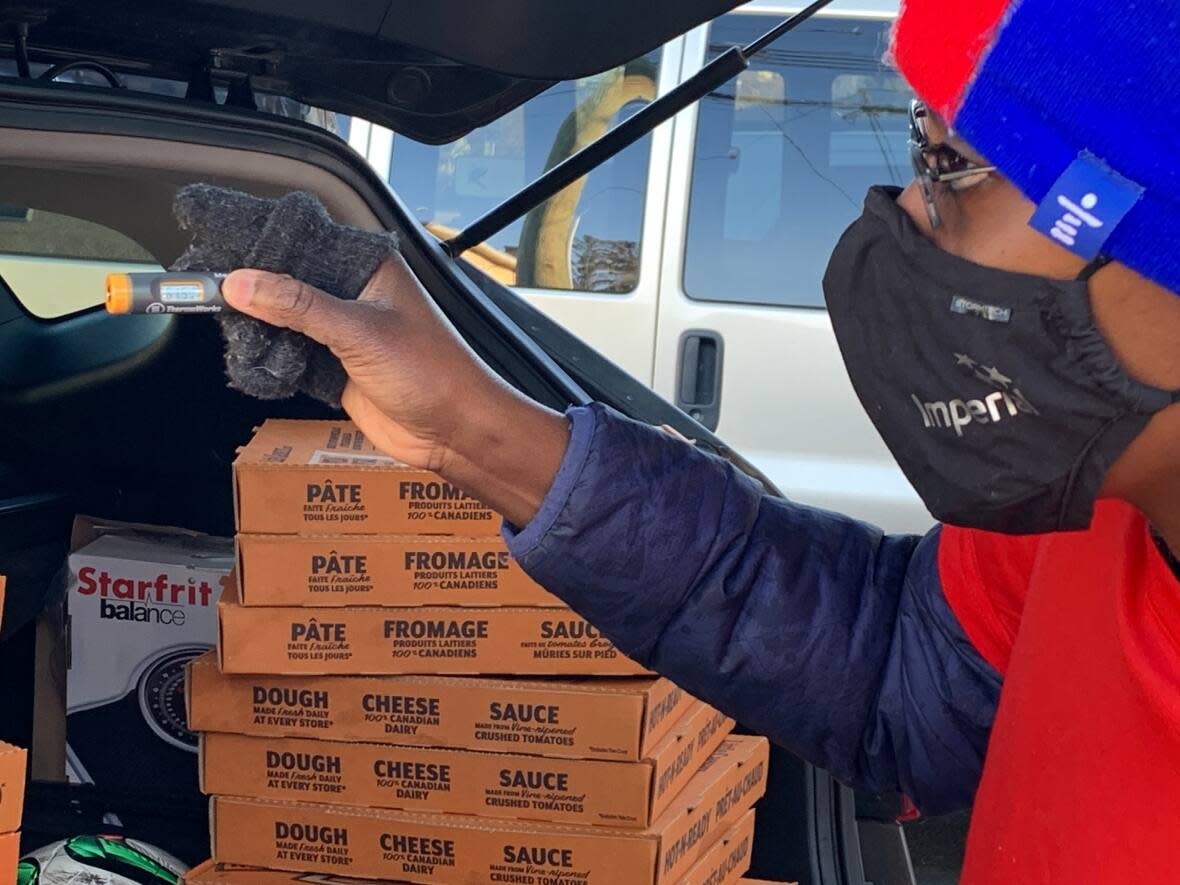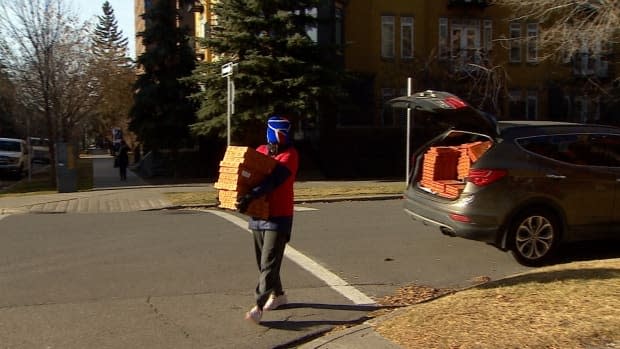Millions of pounds of food 'rescued' as waste diversion pushes food to charity sector

Every Wednesday on her lunch break, Leftovers volunteer Toks Bakinson jumps in her car and drives to Little Caesars on 17th Avenue.
She fills the trunk and backseat with unsold, refrigerated pizza, checks the temperature of the boxes to ensure food safety, then drives to a local youth drop-in centre and marches stack after stack of pizza into the building.
It's roughly $1,500 worth of unsold pizza — a gift to the community through a food rescue app that Bakinson feels great about.
But she's also worried.
"It's a solution for the homeless shelters because now they don't have to think about providing food for their residents for quite a while. I mean, look at this amount of pizza," she says.
"But I think it's a Band-Aid because it gives the businesses an excuse to waste food. They're like, 'Oh, we're going to donate it so it doesn't matter how many they make.'"
Welcome to the complex world of food rescue.
Cell phone apps that make it easier for grocery stores, restaurants and catering companies to donate food have taken off, especially in the last year.
Last month alone, 39 restaurants saved their excess usable food and gave it charities through the non-profit Leftovers.
WATCH | See how much food this volunteer rescues in just one trip to help feed others
Another 105 grocers, caterers and restaurant chains in Calgary donated through an app from the non-profit Second Harvest since September.
Still others donated through the post-secondary initiative Zero Food Waste for the on-campus food bank, and in addition, 26 local grocery stores have made a commitment to be zero waste, working with the B.C.-based organization Loop Resource to redirect everything unsold to 12 charities or 375 local farmers.
And there are other apps, too.
These programs are filling hungry bellies and have kept millions of pounds of food from getting composted or thrown away.
It's changing the industry. But even as all this swiping, picking up and delivering goes on, some leaders in the sector wonder if it's ignoring the root cause of the food waste and the hunger it tries to fix.
But first, who is happy?
Little Caesars store manager Souhail Vibs says using the Leftovers app has made it easy to donate.
His store has many unsold pizzas because they pre-bake some for customers in a rush. Those can't sit longer than 30 minutes.
"We like to help the community, especially during COVID. A lot of people are in need and we have to care for each other," he says.
The pigs come running
Using the Loop Resource app, Scott Judson is also happy. He and his wife have a small mixed farm with a bed and breakfast near Strathmore. He's used the Loop for two years, driving to Calgary multiple times a week to visit Save-on-Foods and Superstores and pick up old produce for the pigs and chickens.
"It's certainly a blessing," Judson said. "I've got healthy animals; they love the treats. They come running when you come [with] it. And I've been able to expand a bit with my farm because it's easier to feed them, especially this year when hay is short.
"It's a free program. We're very, very pleased with it."

Keely McConville is happy, too. She flagged this program for CBC Calgary's high cost of food project after Judson and his wife saved her from starving or a relapse when they paid it forward.
McConville was stuck four weeks ago when her IV supplies, medications and wheelchair repairs were more than the monthly $1,700 disability stipend she gets from the government. Her illness and severe food allergies mean she can't use most of what comes in a food bank hamper.
But Judson fills her fridge with meat and produce every time she's been desperate.
"I wouldn't be alive without healthy, nutritious food," she said. "If it weren't for the kindness of pure strangers, I don't think I would have eaten for the majority of this year, to be honest. What's made [Judson and his wife] able to do that is these programs. She said the Loop saved her farm."
So where has this new attention to food rescue come from?
Waste rules and new technology
The City of Calgary passed a bylaw in 2017 that requires all businesses to separate food out of the regular waste stream. It's no longer legal to simply throw it in the dumpster.
At the same time, advocates in the food and environmental sector have been raising awareness of just how much food waste there is. The Toronto-based non-profit Second Harvest partnered with a business advisor, Value Chain Management International. In 2019, they published a report saying 58 per cent of all food is lost or wasted in Canada, and 32 per cent of that is avoidable.
These cell phone apps were developed to make food rescue easier. Many of them charge the restaurant or grocer to post the food, since they're the ones saving on waste fees, and either volunteers or charity staff pick it up.
The effort exploded in the last year.
For Second Harvest, "because of COVID, everything got escalated," said Jennifer McGlashan, head of their Western Canada operations.
"We got [federal] funding to expand into all the provinces. There was just so much excess food [with the shutdowns] and the growth in need was there. We went from one in eight facing food insecurity to one in seven overnight."
In Alberta, the Second Harvest app alone rescued and redistributed three million pounds of food last year.
But there are concerns.

A burden on charities
James McAra, head of the Calgary Food Bank, says they recently tested one well-known app and found 40 per cent of what they picked up could not actually be passed on to hungry clients. It was only fit for animals, which meant the food bank had to spend volunteer time sorting and getting it to farmers or a compost.
"It's not worth our time to pick it up," he said. "Why do we have to search through garbage in order to feed people? You just dumped [the food waste] onto a charity and now the charity has to deal with it."
Instead, he says, grocers who are donating should think of the root cause of hunger: income. "Can your staff afford your product?"
Even Lori Nikkel, head of Second Harvest, says food rescue is not the main approach Canada should encourage long term. It's temporarily feeding people, and is helping businesses achieve the environmental goal of reducing waste.
"But really, the big solution is prevention," she says.

A home for the pizza
Meanwhile, what happened to all those free pizzas Bakinson delivered? They were appreciated, even in such a large quantity.
Manager Jen Hosie says the Avenue 15 youth centre has eight freezers to handle donations like this; abundance means every young person that stops by can leave with one or two boxes. Staff bring pizza when they make house visits, too, since a tight budget is one reason young people can be at risk to begin with.
In this case, staff even had enough pizza to load a car and drive it to a nearby women's shelter.
"Pizza is a big treat," says Hosie. "We're never like, 'Oh, they brought us too much.' … We don't have a food budget. We rely on all these wonderful people."
CBC Calgary: The High Cost of Food
Enter your cellphone number to help CBC Calgary understand the gaps in Calgary's food system, share tips on saving money and help document how the high cost of food is changing the way we eat and shop. Read more of the series here.
You can unsubscribe from our texting app at any time. Read the FAQ.


